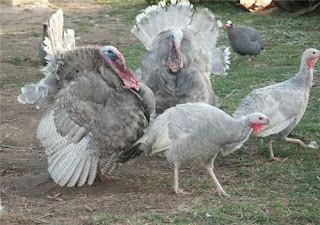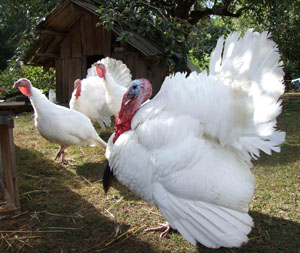Basically, there are
several types of turkey breeds world over and choosing an appropriate breed is
central for a successful rare and this article gives an abridgment of the Heritage Turkey breed:
Notwithstanding the fact
that they are domestic, these breeds are biologically capable of being raised
in a manner that more closely matches the natural behavior and life cycle of
wild turkeys.
Wikipedia
states that the most notable heritage turkeys today come from specific breed.
Heritage turkeys are characteristic of having a relatively longer lifespan and
a much slower growth and for any turkey to be a true heritage turkey they must
meet three specific criteria as below:
1)
They
are able to mate naturally with no intervention from humans, and with expected
fertility rates of 70-80%.
2)
They
are capable of the full normal lifespan of wild turkeys. Breeding hens are
commonly productive for 5–7 years and breeding toms for 3–5 years and also suite
free range conditions in pastured poultry operations.
3)
They
also have a relatively slow to moderate rate of growth compared to turkeys
raised in industrial agriculture that are slaughtered at 14 to 18 weeks of age,
while heritage turkeys reach a marketable weight in about 28 weeks, giving them
time to develop a strong skeletal structure and healthy organs prior to
building muscle mass.
In her article in the self-sufficient home acre
website, Lisa Lynn provides the heritage turkey breed list as below:
1.
Blue Slate
The Blue Slate turkey is a
medium to large sized heritage bird with a wide variation in colors and
markings. The tom is darker in color than the hen. Size is also variable. There
are several color variations, including the Black Slate, Blue Slate and Blue Splash.
The genetic background of this breed is not well known and there is speculation
about its origins.
They are attractive
turkeys that are active foragers and tend toward broodiness. Temperament is
variable.
 |
2. Midget White
The Midget White turkey is
often confused with the Beltsville Small White. This is a small white turkey
developed in the 1950s from crosses between the Royal Palm and commercial white
turkeys. They tend to have a higher percentage of breast meat for their size
compared to some of the other heritage turkeys.
Their small size with
meaty breast, lower feed requirements, and docile nature make them an
attractive turkey for homesteaders. The hens tend toward broodiness and make
good mothers.
 |
| Photo of Midget White turkeys saved from the Livestock Conservancy website |
3.
Narragansett
The Narragansett turkey
hails from the Narragansett Bay area of Rhode Island. It originated in the
1600s from crosses between wild turkeys and domestic turkeys brought from
Europe. They have markings similar to the Standard Bronze. The Narragansett
turkey is a large bird that was favored for meat production before the
development of heavier breeds.
These birds are a good
choice for homesteaders due to their calm temperament, decent egg production,
fine flavored meat, and mothering instinct of the hens. An active forager and a
somewhat flighty breed. However, they have less breast meat than some other
breeds.
 |
4.
Bourbon Red
Bourbon Red turkeys are a
large turkey with chestnut coloration and light colored flight feathers. They
were originally bred in Pennsylvania and later the Bourbon County area of
Kentucky. This breed was popular in the early 1900s until they were replaced by
heavier breeds.
The carcass dresses out
clean due to the light colored pin feathers and they have a good amount of
breast meat for a heritage turkey. These birds are active but fairly docile in
temperament. The hens tend toward broodiness and are good mothers.
 |
| Photo of Bourbon Red turkeys saved from e flow website |
5.
Royal Palm
Royal Palm turkeys are one
of the most attractive turkey breeds, with a striking pattern of light and dark
feathers. They are a medium small breed that is generally raised for their
ornamental appearance. They originated from a mixed flock of turkeys in Florida
in the 1920s.
This is an ornamental
turkey that actively forages and provides insect control. They are flighty
birds with variable temperament and broodiness. Although they don’t have a lot
of meat, the flavor is very good.
 |
| Photo of Royal Palm turkeys saved from Cackle Hatchery website |
6.
White Holland
White Holland turkeys were
bred in Holland from turkeys brought from Central America in the 1500s. This is
a large white breed with a fast growth rate for heritage breeds. They were
commercially important until the development of heavier breeds in the 1900s.
This breed has more breast
meat and a clean looking carcass when dressed, due to the white feathers. They
are variable in temperament and aren’t noted for being especially flighty.
 |
| Photo of White Holland turkey saved from Murray McMurray Hatchery website |
7.
Chocolate
Chocolate turkeys are not
recognized as a standard breed by the APA. They are a large turkey with
chocolate colored feathers. Chocolates were popular in the Southern United
States prior to the Civil War and were almost wiped out during the conflict.
They may be difficult to find, as numbers are limited.
There is a great deal of
variation in this breed. They have more meat than some heritage varieties.
 |
| Photo of Chocolate turkeys saved from Welp Hatchery website |
8.
Black Spanish
The Black Spanish turkey
is also known as the Norfolk Black. They are medium to large turkeys of
striking black with a greenish sheen. This breed was developed in Europe from
turkeys brought back by early explorers. Early colonists in America used these
birds in developing the Bronze Standard, Narragansett, and Slate breeds.
They make a fine addition
to the homestead for their fast growth and good meat production. Temperament is
variable and they are decent foragers.
 |
|
Photo of Black Spanish
turkeys saved from California Hatchery
website
|
9.
Standard Bronze
The Standard Bronze turkey
was developed in Colonial America by crossbreeding wild turkeys with
domesticated birds brought from Europe. They are slow growing, long lived birds
with a beautiful coloration that make a popular image for Thanksgiving decor. This
was a popular turkey in the United States until meatier birds were developed
and favored by commercial growers.
The Standard Bronze is a
large breed with less breast meat, but a delicious flavor. They are active
foragers, somewhat flighty, with a variable temperament.
 |
| Photo of Standard Bronze turkeys saved from Welp Hatchery website |
10. Beltsville
Small White
The Beltsville Small White
turkey was developed by the USDA Research Center in Beltsville, Maryland to
fill the market demand for a small, meaty white turkey in the 1930s. They
remained popular for home cooked turkeys through the 1950s but demand declined
with the production of the Broad Breasted White turkey.
It’s small size, meaty
breast, and clean carcass make it a good choice for small homesteads.
Temperament is variable.
 |
| Photo of Beltsville Small White turkey saved from Halter Icelandic website |
Its always important to understand which breed to rare in a respective environment
ReplyDelete